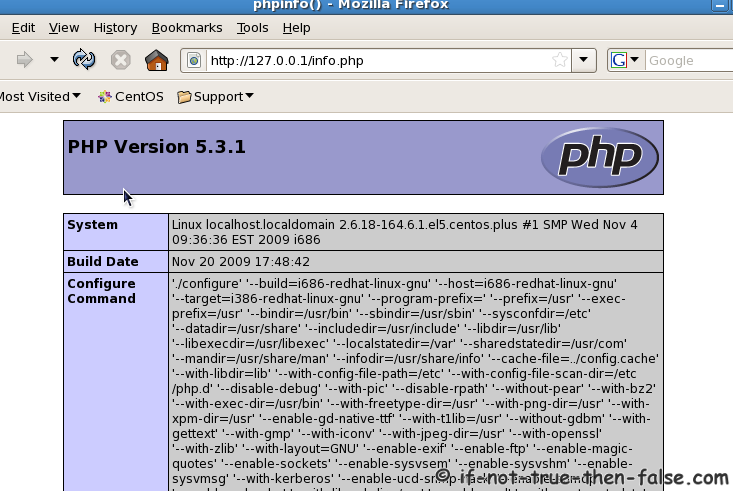nginx, PHP 5.3 and FastCGI on CentOS 5.5, Fedora 13, Red Hat RHEL 5.5/6
Table of Contents
This is guide howto install nginx, PHP 5.3 and FastCGI webserver with MySQL and/or PostgreSQL and Memcache support on Fedora 12 and Fedora 13, CentOS 5.5, Red Hat (RHEL) 5.5/6.
nginx (engine x) is a robust, small and high performance http server, reverse proxy server and also mail proxy server.
1. Add and enable needed repositories:⌗
Updated 19.3.2010⌗
Use following repositories to install nginx 0.8.xx version (currently 0.8.36 version)
rpm -Uvh http://download.fedora.redhat.com/pub/epel/5/i386/epel-release-5-4.noarch.rpm
rpm -Uvh http://rpms.famillecollet.com/enterprise/remi-release-5.rpm
rpm -Uvh http://yum.chrislea.com/centos/5/i386/chl-release-5-3.noarch.rpm
rpm --import /etc/pki/rpm-gpg/RPM-GPG-KEY-CHL
Just Epel repository is now obsolete, since there can be found only nginx 0.6.xx branch (currenlty version 0.6.39) Check this comment for more info.
rpm -Uvh http://download.fedora.redhat.com/pub/epel/5/i386/epel-release-5-4.noarch.rpm
rpm -Uvh http://rpms.famillecollet.com/enterprise/remi-release-5.rpm
2. Install following packages:⌗
- nginx
- php
- php-mysql
- php-pgsql
- php-pecl-memcache
- fcgi
- spawn-fcgi
with following command:
yum --enablerepo=remi install nginx php php-mysql php-pgsql php-pecl-memcache fcgi spawn-fcgi
...
Dependencies Resolved
=================================================================================================
Package Arch Version Repository Size
=================================================================================================
Installing:
fcgi i386 2.4.0-4.el5 epel 43 k
nginx i386 0.6.39-2.el5 epel 318 k
php i386 5.3.1-1.el5.remi remi 1.3 M
php-mysql i386 5.3.1-1.el5.remi remi 140 k
php-pecl-memcache i386 3.0.4-2.el5.remi.1 remi 64 k
php-pgsql i386 5.3.1-1.el5.remi remi 119 k
spawn-fcgi i386 1.4.22-2.el5 epel 17 k
Transaction Summary
=================================================================================================
Install 7 Package(s)
Update 0 Package(s)
Remove 0 Package(s)
3. Add Fast-CGI init script:⌗
Save following script to /etc/init.d/phpfcgi file.
#!/bin/bash
#
# Startup script for the PHP FastCGI server.
#
# chkconfig: 345 85 15
# description: PHP is an HTML-embedded scripting language
# processname: php
# config: /etc/php.ini
# Source function library.
. /etc/rc.d/init.d/functions
SPAWNFCGI="/usr/bin/spawn-fcgi"
PHPFCGI="/usr/bin/php-cgi"
FCGIPORT="9000"
FCGIADDR="127.0.0.1"
PHP_FCGI_CHILDREN=5
PHP_FCGI_MAX_REQUESTS=1000
ALLOWED_ENV="PATH USER"
USER=nginx
GROUP=nginx
#PHPUSER=php
PIDFILE=/var/run/phpfcgi.pid
if [ -z "$PHP_FCGI_CHILDREN" ]; then
PHP_FCGI_CHILDREN=5
fi
ALLOWED_ENV="$ALLOWED_ENV PHP_FCGI_CHILDREN PHP_FCGI_MAX_REQUESTS FCGI_WEB_SERVER_ADDRS"
case "$1" in
start)
PHPFCGI_START=$"Starting ${NAME} service: "
echo -n $PHPFCGI_START
# check for $PHPUSER, create if non-existent
if [ -z "`id -u $PHPUSER 2> /dev/null`" ]; then
useradd -s /sbin/nologin $PHPUSER
fi
# clean environment
E=
for i in $ALLOWED_ENV; do E="$E $i=${!i}"; done
#daemon --user $PHPUSER --pidfile $PIDFILE "env - $E $PHPFCGI -q -b $FCGIADDR:$FCGIPORT &> /dev/null &"
daemon $SPAWNFCGI -a ${FCGIADDR} -p ${FCGIPORT} -u ${USER} -g ${GROUP} -P ${PIDFILE} -C ${PHP_FCGI_CHILDREN} -f ${PHPFCGI}
retval=$?
#pid=`pidof php-cgi`
#if [ -n "$pid" ]; then
# echo $pid > $PIDFILE
# success $PHPFCGI_START
#else
# failure $PHPFCGI_START
#fi
#echo
;;
stop)
echo -n "Stopping php-fcgi: "
killproc -p $PIDFILE phpfcgi
echo
;;
status)
status phpfcgi
;;
restart)
$0 stop
$0 start
;;
*)
echo "Usage: $0 {start|stop|status|restart}"
exit 1
esac
exit 0
Originally from here: http://wiki.nginx.org/RedHatPHPFCGIInitScript, but modified little bit, because original script not worked.
Now normal start, stop, status, restart should work:
/etc/init.d/phpfgci start
/etc/init.d/phpfgci stop
/etc/init.d/phpfgci status
/etc/init.d/phpfgci restart
4. Configure nginx:⌗
Modify /etc/nginx/nginx.conf file following rows:
worker_processes 2;
keepalive_timeout 25;
gzip on;
# pass the PHP scripts to FastCGI server listening on 127.0.0.1:9000
#
location ~ \.php$ {
root /usr/share/nginx/html;
fastcgi_pass 127.0.0.1:9000;
fastcgi_index index.php;
fastcgi_param SCRIPT_FILENAME /usr/share/nginx/html$fastcgi_script_name;
include fastcgi_params;
}
# deny access to .htaccess files, if Apache's document root
# concurs with nginx's one
#
location ~ /\.ht {
deny all;
}
5. Start FastCGI and nginx services:⌗
/etc/init.d/phpfcgi start
/etc/init.d/nginx start
6. Create PHP file and print phpinfo:⌗
echo "<?php echo phpinfo(); ?>" > /usr/share/nginx/html/info.php
7. Test info.php file:⌗
Go to http://127.0.0.1/info.php and check that everything is working.
